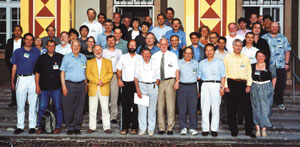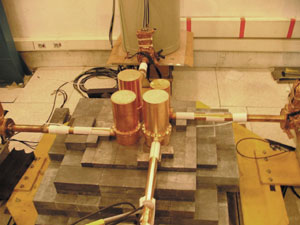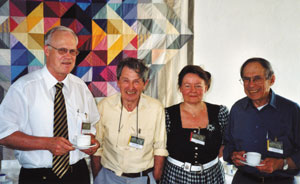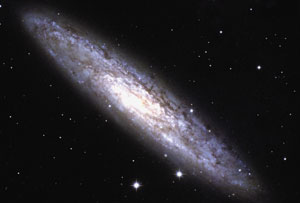The fourth conference in the “Beyond” series presented a clear overview of – and beyond – the current frontiers of particle physics, astrophysics and cosmology.

New developments in extensions of the Standard Model, through supergravity, superstrings and extra dimensions, were among the highlights of “Beyond the Desert 03 – Accelerator, Non-accelerator and Space Approaches”, which was held last year in Castle Ringberg in Tegernsee, Germany. Supergravity had recently celebrated its 20th birthday and two of its “inventors” – Pran Nath and Richard Arnowitt – were among the participants at the conference.
Nath, of Northeastern University, Boston, summarized the developments of minimal supergravity grand unification (mSUGRA) and its extensions since the formulation of these models in 1982, while Arnowitt, from Texas A&M, highlighted the connection to dark matter and the value of g-2 of the muon. Focusing on quantum gravity, Alon Faraggi of Oxford argued that the experimental data of the past decade suggest that the quantum-gravity vacuum should possess two key ingredients – the existence of three generations and their embedding into SO(10) representations. He explained that the Z1 x Z2 orbifold of the heterotic string provides examples of vacua that accommodate these properties. He also showed that three generations require a non-perturbative breaking of the grand unification gauge group, and in this context examined the issue of mass and mixing in the neutrino versus the quark systems.
Fundamental physics, including fundamental symmetries, formed another important aspect of the meeting. Peter Herczeg from Los Alamos reviewed CPT-invariant, and CP- and P-violating electron-quark interactions in extensions of the Standard Model. Turning to fundamental constants, Harald Fritzsch of Munich discussed astrophysical indications that the fine structure constant has undergone a small time variation during the cosmological evolution, within the framework of the Standard Model and grand unification. The case where the variation is caused by a time variation of the unification scale is particularly interesting.
Interferometry
The potential of neutron interferometry for tests of fundamental physics was outlined by Helmut Rauch of Vienna. Recent experiments in neutron interferometry, based on post-selection methods, have renewed the discussion about quantum non-locality and the quantum measuring process. It has been shown that interference phenomena can be revived when the overall interference pattern has lost its contrast. This indicates a persistent coupling in phase space, even in cases of spatially separated Schroedinger-cat-like situations.
Interesting developments in general relativity and aspects of special relativity were also discussed at the conference. Mayeul Arminjon of Grenoble presented a new “scalar ether theory” of gravitation. One of the motivations for trying such an alternative approach is to solve problems that occur in general relativity and in most extensions of it – namely the existence of singularities and the interpretation of the gauge condition. Arminjon showed that this scalar theory fits nicely with observations on binary pulsars. Lorenzo Iorio of Bari reported on new perspectives in testing the general relativistic Lense-Thirring effect. Turning to experiment, the present status of the search for gravitational waves was outlined by Peter Aufmuth of Hannover. Only astrophysical events, such as supernovae, or compact objects, for example, black holes and neutron stars, produce detectable gravitational wave amplitudes. The current generation of resonant-mass antennas and laser interferometers has reached the sensitivity necessary to detect gravitational waves from sources in the Milky Way. Within a few years the next generation of detectors will open the field of gravitational astronomy.
Cosmological connections
Talks about the early universe included cosmological, quantum-gravitational and other possible violations of CPT symmetry. Nick Mavromatos of King’s College, London, discussed the various ways in which CPT symmetry may be violated, and reviewed their phenomenology in current or near-future experimental facilities, both terrestrial and astrophysical. First he outlined violations of CPT symmetry due to the impossibility of defining a scattering matrix as a consequence of the existence of microscopic or macroscopic space-time boundaries, such as Planck-scale black-hole event horizons or cosmological horizons due to the presence of a positive cosmological constant in the universe. Second he discussed CPT violation due to the breaking of Lorentz symmetry, which may characterize certain approaches to quantum gravity. He stressed that although most of the Lorentz-violating cases of CPT breaking are already excluded by experiment, there are some (stringy) models that can evade these constraints.
Trans-Planckian physics was discussed by Ulf Danielsson of Uppsala, who outlined how the cosmic microwave background radiation might probe physics at or near the Planck scale. Danielsson reviewed a potential modulation of the power spectrum of primordial density fluctuations generated through trans-Planckian (maybe stringy) effects during inflation.

Margarida Rebelo of Lisbon discussed CP violation in the leptonic sector at both low and high energies in the framework of the “seesaw” mechanism. She pointed out that leptogenesis is a possible and likely explanation for the observed baryon asymmetry of the universe. It seems to be one of the most promising scenarios, in view of the fact that several other alternative proposals are on the verge of being ruled out. The leptogenesis scenario implies constraints on both light and heavy neutrino masses, which, as she showed, are consistent with the present value obtained from the double beta decay of 76Ge.
Cosmoparticle physics was another major theme of the conference. Maxim Khlopov of Rome and Moscow gave a broad overview of the topic, calling it the “Challenge for the Millennium”, and results linking particle-physics experiments with cosmological problems, and vice versa, were among the experimental highlights.
The existence of dark matter in the universe has for many years been an intriguing problem. Rita Bernabei of Rome presented the final results of the DAMA dark-matter experiment, which confirm their first indications for the observation of cold dark matter at a 6 σ level. Measurements of the cosmic microwave background by the Wilkinson Microwave Anisotropy Probe (WMAP), which are revealing the proportions of dark matter – and dark energy – in the universe, were presented by Eiichiro Komatsu of Princeton. Neutrino parameters are also deducible from this experiment, as well as from current large-scale galaxy surveys, as Steen Hannestad of Odense described. However, the cosmic microwave background experiments cannot at present differentiate between the different neutrino-mass scenarios.
Neutrino highlights
Moving on to ground-based studies of neutrino properties, the Heidelberg-Moscow double beta decay experiment in the Gran Sasso Laboratory has results for the period 1990-2003, which were presented by Hans Volker Klapdor-Kleingrothaus of MPI Heidelberg. With three additional years of data included in this analysis, the evidence for neutrinoless double beta decay has now improved to a 4.2 σ level. For 10 years this experiment has been the most sensitive double beta experiment worldwide, and with the statistics now reached, it has essentially already achieved scientifically what was expected from the larger GENIUS project proposed in 1997. The conclusion from this result is that the total lepton number is not conserved (neutrino oscillations reveal only the violation of family lepton number). This has fundamental consequences for the early universe. Furthermore, according to the Schechter-Valle theorem, the existence of neutrinoless double beta decay implies that the neutrino is a Majorana particle. (The announcement of the start of the GENIUS Test Facility in Gran Sasso, in May 2003, was now of most interest in the context of the search for dark matter. The goal of the GENIUS Test Facility is to confirm the DAMA result by looking for the seasonal modulation signal.)

On the theoretical side Mariana Kirchbach of San Luis Potosi in Mexico stressed the importance of double beta decay for fixing the absolute scale of the neutrino mass spectrum. She showed that in the case of Majorana neutrinos, in single beta decay the mass might lead to unexpected results. In this scenario a sensitive tritium decay experiment should see no mass if the neutrino is a Majorana particle, while the dependence of the neutrinoless double beta decay rate. Ernest Ma of Irvine outlined how a rather precise knowledge of neutrino oscillation parameters, i.e. the correct form of the 3 x 3 neutrino mass matrix, may be obtained from symmetry principles. He showed that the latter predict three nearly degenerate Majorana neutrinos with masses in the 0.2 eV range. This theoretical result is of great interest, in view of the results from double beta decay, WMAP, etc.
Contributions to fundamental physics, obtained using Penning traps, were outlined by one of the pioneers of the field, Ingmar Bergstrom of Stockholm. A Penning trap is a storage device in which frequency measurements can be used to determine the mass of electrons and ions, as well as g-factors of electrons and positrons, with extremely high accuracy. Bergstrom has recently measured, for example, the Q value of the double beta decay of 76Ge with unprecedented precision.
Other experimental highlights on neutrinos included the results obtained for solar neutrinos by the Sudbury Neutrino Observatory (SNO). As George Ewan of Kingston, Canada, described, SNO now has strong evidence at a 5.3 σ level, and independently of the details of solar models, that neutrinos change flavour on their way from the Sun to the Earth. These results, together with those of other neutrino experiments, among them the Japanese 250 km long-baseline experiment that was presented by Takashi Kobayashi of KEK, mean that our knowledge of neutrino properties has improved considerably over the past few years. In this context, Oliver Manuel of Missouri gave a highly interesting, non-mainstream view of the structure of the solar core.
Supernova and relic neutrinos were the topic of another session. Irina Vladimirovna Krivosheina of Heidelberg and Nishnij-Novgorod, who was a member of the Baksan group that was one of three groups which observed neutrinos from the supernova SN1987A, gave a retrospective view of this exciting event and some insider details of its discovery. Mark Vagins of Irvine and Shinichiro Ando of Tokyo discussed further the observation of relic and supernova neutrinos, one of the future tasks of the Super-Kamiokande experiment in Japan.
Accelerator approaches
Turning to the physics of nuclei, results on superheavy elements have reached an exciting level. Dieter Ackermann showed that elements 107-112 have been synthesized and unambiguously identified at GSI, Darmstadt. The observation of elements 112, 116 and 118 by the Oganessian group at Dubna was also announced by Vladimir Utyonkov. At the interface between nuclear physics and particle physics, the status of the search for a phase transition between hadronic matter and a quark-gluon plasma at Brookhaven’s Relativistic Heavy Ion Collider was outlined by Raimond Snellings of Amsterdam, and compared with measurements at CERN’s Super Proton Synchrotron.

Several sessions were devoted to the search for new physics with colliders. The final analyses of the search for Higgs bosons, R-parity violation, leptoquarks and exotic couplings at CERN and Fermilab, presented by Rosy Nikolaidou of CEA Saclay, Silvia Costantini of Rome “La Sapienza”, Stefan Soeldner-Remboldt of Manchester and others, show no indication of physics beyond the Standard Model. This reinforces the observation that the only new physics to emerge recently is from underground experiments.
Particles from space
Nearly a century after the discovery of cosmic rays, their origins are still unknown. Eckart Lorenz of Munich reviewed the status and perspectives of ground-based gamma-ray astronomy, where new telescopes under construction, such as MAGIC, should lead to a big step in sensitivity. At gamma-ray energies of around 10-30 GeV the universe becomes basically transparent, so gamma-emitting objects as far as red-shifts of more than three should become visible, that is, up to a time where star and galaxy formation has been particularly strong. New projects like MAGIC will allow the gap to be closed between satellite-borne instruments and previous, ground-based telescopes. Exciting results from the CANGAROO experiment, an array of four imaging Cherenkov telescopes in Australia, were presented by Ken’ichi Tsuchiya of Tokyo. The team has observed TeV gamma rays from SNR SN1006 and from new types of objects, such as gamma rays from a normal spiral galaxy showing starburst activity, NGC253. This is the first detection of gamma rays from an extragalactic object other than active galactic nuclei, and is the largest structure ever detected.
The Auger Observatory is under construction and will look for cosmic rays at the highest energies. It will be the largest cosmic-ray detector ever built, covering 3000 square kilometres in both the southern and northern hemispheres in its final configuration. Johannes Bluemer of Karlsruhe described the present status of the construction at the southern site in Argentina, which began in 1999.
The highest cosmic energies, beyond the Greisen-Kuzmin-Zatsepin limit, find an interesting theoretical explanation in the Z-burst scenario, in which a large fraction of the cosmic rays are decay products of Z-bosons produced in the scattering of ultra-high-energy neutrinos on cosmological relic neutrinos. This was discussed by Daniel Fargion of Rome and Sandor Katz of DESY and Budapest. Interestingly, they find that neutrinos should have a mass in the range of 0.1-1 eV – which is consistent with the result of the HEIDELBERG-MOSCOW experiment – in order to make this explanation work properly.
Hunting for antimatter
The search for antimatter (and dark matter) with the Alpha Mass Spectrometer, which is planned to be installed on the International Space Station in 2005/2006 for a three-year mission, was discussed by Frank Raupach of Aachen. The existence of large domains of antimatter in the universe is still an open question. The observed uniformity of the cosmic microwave background indicates that no voids exist at all between matter and antimatter worlds, hence annihilation processes should be inevitable and the resulting diffuse gamma-ray spectrum might be observable.
Returning to neutrinos, but this time from space, Christian Spiering of Zeuthen gave an overview of results from AMANDA, the neutrino telescope at the South Pole, and Jan-Arys Dzhilkibaev reviewed the status and perspectives of the Baikal Neutrino Project. Finally, Yoshitaka Kuno from Osaka outlined the goals of future neutrino and muon factories. A neutrino factory would have great potential for examining the mass hierarchy of neutrinos, the matter effects, and CP violation in the neutrino sector. A rich physics programme would also be possible with a high-intensity muon beam at a muon factory, ranging from searches for muon processes that violate lepton flavour (such as µ– to e– conversion) and the muon electric dipole moment to further precision measurements of the muon magnetic moment (g-2). Lepton flavour violation in the charged sector will be studied also by the muon to electron conversion experiment, MECO, presented by Michael Herbert of Irvine.
In summary, the lively and highly stimulating atmosphere during this Beyond meeting reflected a splendid scientific future for particle physics. The proceedings of Beyond 03 are now available as a book, Beyond the Desert 2003, Springer Proceedings in Physics, vol 92.





